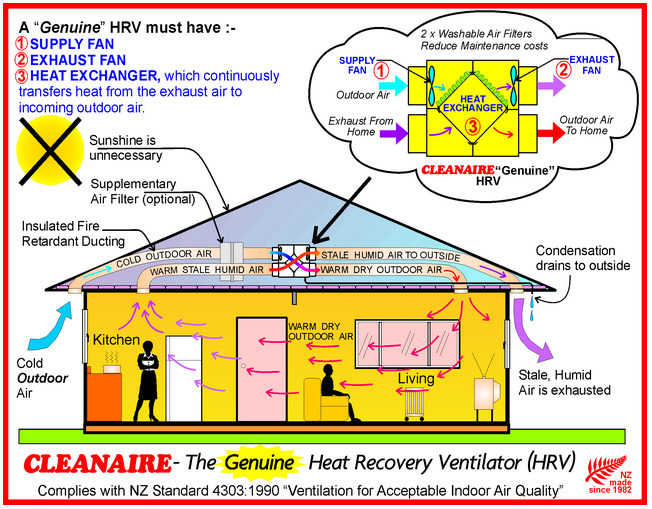Genuine Heat Recovery Ventilation
Only a genuine Heat Recovery Ventilation System will deliver fresh outdoor air throughout your home

The above graphic shows "fresh air" entering the HRV and passing through the heat exchanger and being ducted to the house as warm dry fresh air. The same volume of air is then extracted as "warm stale humid air and passes through the heat exchanger in the opposite direction to go outside as stale moist air. The heat exchanger will collect up to 95% of the outgoing heat to be recycled back into the fresh incoming air, so most of your valuable heat stays inside where you want it.
Condensation and mold is therefore eliminated or reduced while maintaining a constant fresh air environment and minimizing the heating required to maintain a comfortable internal temperature. If your home has lower humidity the air can actually feel warmer. An HRV system is not a heater - it simply transfers waste exhaust heat to incoming fresh air and maintains separate extract and intake air flows. Understanding More About Moisture
See the difference between Genuine HRV and the others
Saving Heat Energy
Depending on the heat exchanger model you choose, between 80 and 95 percent of the heat energy is recovered from the extracted air and so ventilation heat loss is enormously reduced, and due to the heat exchanger the system pays back its cost by recovering up to five times more energy than the energy consumed by the two fans.
Heat Recovery Ventilation in Summer
For air-conditioned homes, the HRV recovers and recycles ?cooled energy?, saving summer energy costs. If your home is not air conditioned, and your lifestyle is to have windows open in summer, switch the HRV OFF. Optional automatic controls are available.
Importance of Building Airtightness
Infiltration due to air leakages (draughts) in the building envelope cause additional ventilation heat loss without heat exchange, which can exceed the scheduled ventilation heat loss of the HRV system, especially when using very efficient heat exchangers.
In buildings with poor air tightness (most pre 1980's homes) the ventilation heat loss is therefore mainly affected by air leakages. Improving the air tightness of the building envelope will reduce ventilation heat loss considerably and optimize the performance of your HRV system.
Beware of Imitations!
Before you decide on a ventilation system, make sure it brings in outdoor air and not roof space air!
NZ Standard 4303 "Ventilation for Acceptable Indoor Air Quality" requires outdoor air for ventilation. Roof space air is not outdoor air. It may be polluted by dust, loose insulation fibres and biological contaminants, which are a potential health risk when inhaled. Biological contaminants will accumulate on air filters; most allergens pass through even the best air filters. Inspect your roof space through the manhole. Decide yourself, what you want to breath - fresh or polluted air.
Besides, attic or roof space fans pressurize the home and force your valuable warm air to the outside and into walls and other cavities, where it may cause mould/mildew problems and structural rot as a result of condensation. The fans may cost "cents to run", but what is the cost of the warm air forced out of your home? An electric 1 kW heater to replace that wasted heat, running 24 hrs a day, will add $180 to your monthly power bill (@ 25 cents per kWh).
Contact us for a free home assessment.
Further Infomation:
The Cleanaire HRV is supported by an extensive Warranty
Cleanaire HRV Brochure